— by Stephen Fontenot and Amanda Siegfried —
Embracing sustainability is an integral part of The University of Texas at Dallas’ strategic plan. That commitment to minimizing the University’s environmental footprint can be seen throughout campus in resource conservation, composting, care of the natural environment and recycling.
The UT Dallas research enterprise is also committed to advancing sustainable practices and developing technologies dedicated to the stewardship of the environment and the health of the planet and its inhabitants. Going beyond the familiar refrain of reduce, reuse and recycle, faculty members in multiple disciplines are exploring diverse, innovative ideas while encouraging their students to be creative problem-solvers.
“The reason we do what we do is not just to write journal articles. It’s to engage in science that can make a difference by helping policymakers and stakeholders make decisions based on the latest science,” said Dr. David Hyndman, dean of the School of Natural Sciences and Mathematics and a hydrogeologist whose research focuses on the dynamics of the planet’s water cycle.
Since joining the faculty in 2021, he and colleagues in the Office of Research and Innovation have organized symposia where UTD researchers can come together to discuss their sustainability-related projects.
“We need to combine technical advances from the sciences, engineering, public policy, sociology and other disciplines to address on-the-ground realities and examine the tangible economic outcomes of past and potential future choices,” he said.
Sustainability refers to the stability and equitable distribution of energy, food and water resources over time.
“Sustainability encompasses many different components that must work together so that humans today have stable supplies of food, water and energy to support the growing population,” Hyndman said. “It is also important to consider how we can sustain ecosystems that, as a result of our historical activities, are having some real issues.”
From water- and land-use management to energy-efficient buildings, from food-waste solutions to new ways of leveraging renewable resources, here is a snapshot of some of the ways UT Dallas researchers are helping to ensure a sustainable future.
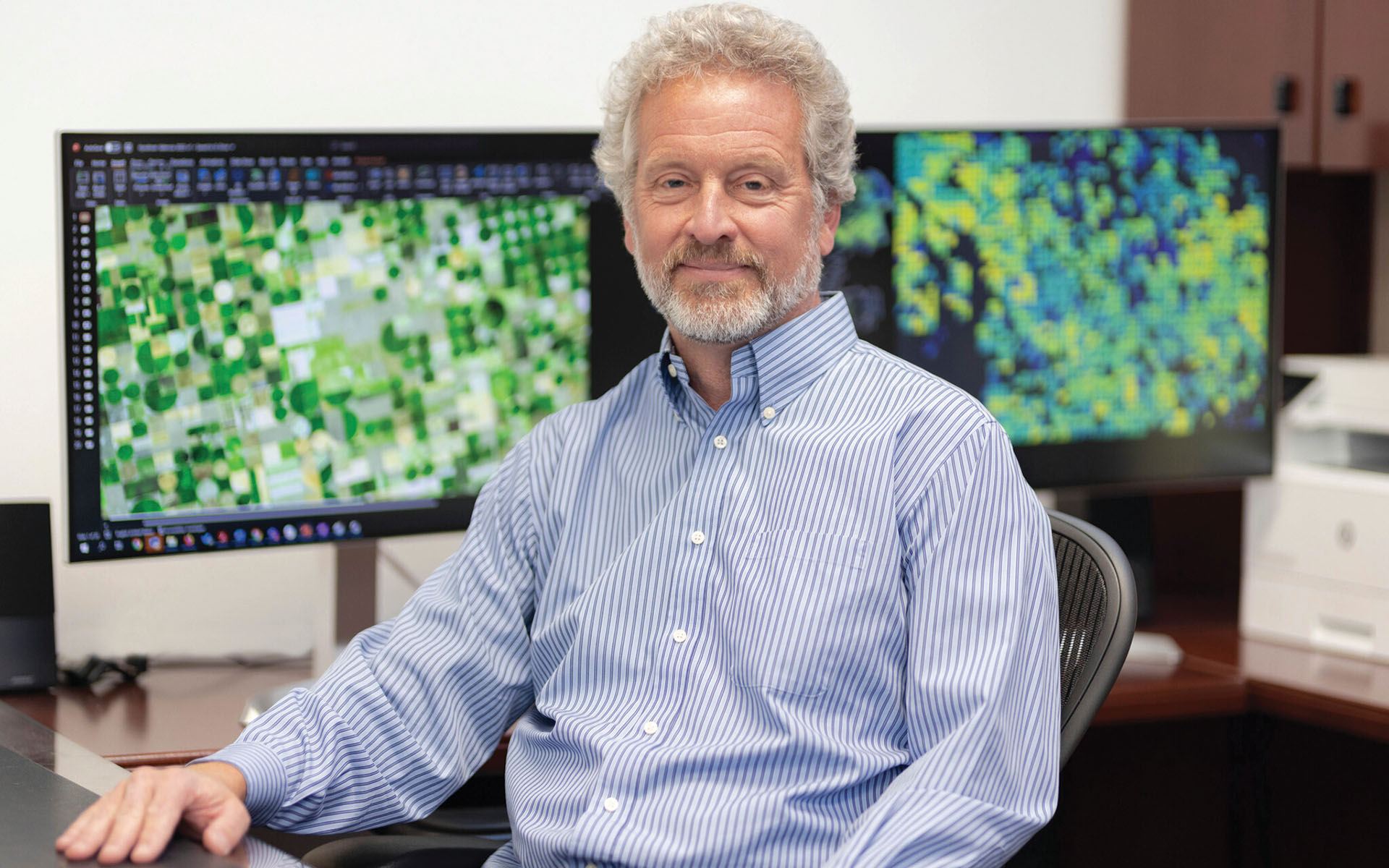
Dr. David Hyndman
Disappearing Water
Rising global temperatures have led many parts of the planet to become more arid. Coupling climate change with increasing water use, freshwater supplies are headed toward crisis, illustrated by the 22-year megadrought in the western U.S.
Hyndman, who is also the Francis S. and Maurine G. Johnson Distinguished University Chair, studies how water gets into the ground and interacts with soil and rock, and how human activity impacts the water cycle. For more than 25 years, his research has been funded by the National Science Foundation (NSF), NASA, the U.S. Department of Agriculture (USDA) and other agencies.
Hyndman said that in most regions where large-scale irrigated agriculture exists, the available water supply is declining drastically. Groundwater is being mined at a much faster rate than the aquifers are being recharged.
“For instance, in the case of the Colorado River, many areas of the region, including central Arizona, are using an unsustainable amount of water, made apparent by the severe decline in reservoir levels,” he said. “The High Plains aquifer, which runs from South Dakota to northern Texas, has had so much groundwater withdrawn that some areas can’t irrigate their crops. That’s going to happen on a much larger scale.”
Freshwater is stored in the environment primarily as groundwater, reservoirs and snowpacks. But snowpack has dramatically shrunk as temperatures have risen worldwide and precipitation has become more erratic.
“The most significant drivers of aridity are increases in temperature and variability in precipitation,” Hyndman said. “A secondary effect of climate change has been less frequent, but more intense, rainstorms. This means less rain can percolate into aquifers that store groundwater. At the same time, plants are using more water because it’s more arid.”
Hyndman said high-resolution satellite imagery, combined with artificial intelligence, can track landscape changes and help scientists and policymakers understand the effects of multiple factors at local and regional scales. For example, increased solar-panel use in California’s Central Valley contributes to renewable energy while also reducing the amount of land that needs irrigation. And monitoring canopy density of plants can help predict evaporation and transpiration rates, which can help predict water-cycle changes.
“If our models that incorporate all this information can accurately describe how changes have occurred,” Hyndman said, “they can inform ways to better manage resources.
“Research can find a way to mitigate some things — how we irrigate and where we get our water. But there’s no easy way to get new water to the High Plains. We need to think outside the box and do science that can inform policies that move toward sustainability.”
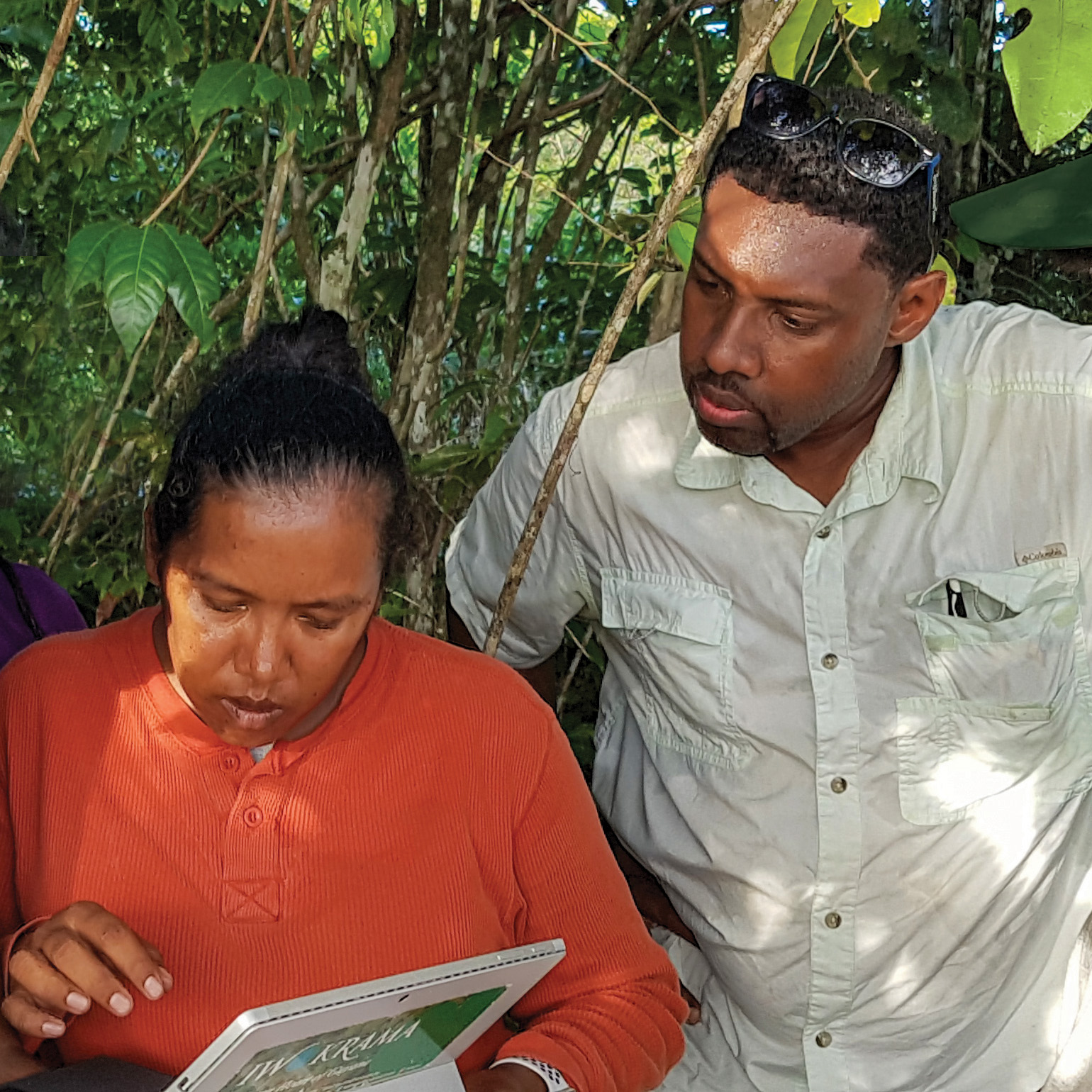
Dr. Anthony Cummings traveled to Guyana to learn from the Makushi indigenous community.
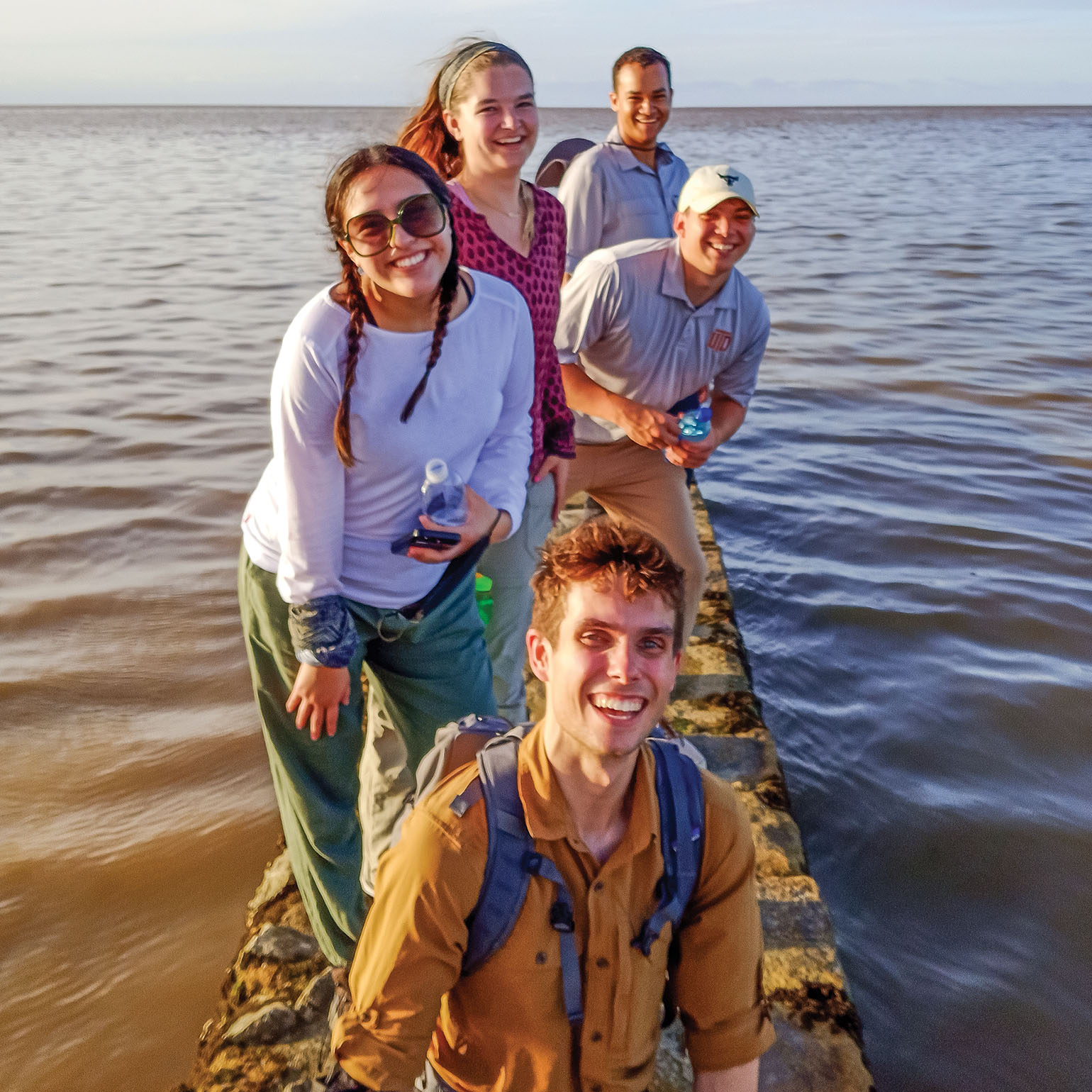
The five UT Dallas students who visited Guyana with Cummings are (front to back): John Sadler, Christina Lam, Paulina Hruskoci, Daniel Zamora and Nicholas Porter.
Land Lessons
In the quest for sustainability, Dr. Anthony Cummings has returned to his origins to gain insight that could benefit humanity.
Cummings, associate professor of geospatial information sciences in the School of Economic, Political and Policy Sciences, grew up along the Caribbean coast of Guyana in South America. In the summer of 2021, he and five UT Dallas students spent two weeks there to learn from the Makushi indigenous community.
“Indigenous peoples possess skills and histories that we need to understand,” Cummings said. “We must collaborate with them to harness nature in a way that helps other societies better understand how relations with the Earth can improve.”
Cummings’ research — funded most recently by an NSF Faculty Early Career Development Program (CAREER) grant — has taken him far inland to the Rupununi, which borders the Brazilian Amazon rainforest. Inhabitants there rely on the forests and savanna grasslands to sustain their livelihoods. The people of the Rupununi hunt animals that are harbored on their farms and maintain strong connections to the flora and fauna via methods passed from one generation to another.
“For too long this knowledge has been disregarded as less valuable than scientific knowledge,” Cummings said. “We must appreciate it and place Western scientific knowledge in harmony with their way of doing things.”
Using drones, Cummings investigates changes in land use in the region and how those changes impact biodiversity and ecosystems. By analyzing local, regional and global factors that influence land use, he hopes that this research can help policymakers develop sustainable global economic policies.
Cummings said that indigenous peoples who live off the land are keen observers of evolving precipitation and temperature trends, and are very concerned by climate change.
“It doesn’t matter what culture you’re in – farmers are some of the most intelligent folks on this planet,” he said. “Speak with farmers, and you’ll realize quickly that they know what’s going on. And if you explain to them how your technology can help them, they are likely to buy in.”
Cummings believes that the indigenous peoples of the tropics will adapt and survive, even in the face of the West’s reluctance to embrace the ways in which indigenous societies function.
“Just because you’re sitting in Dallas, don’t assume that what you drink, what you eat, how you commute doesn’t affect somebody else,” he said. “Every decision we make has implications for somebody elsewhere on the planet. We’re all much more connected than we think.
“We can’t have a sustainable planet if we don’t understand how people shape their environments and the actions we need to take to allow them to continue co-existing in spaces they have occupied for centuries. Changes in land use and land cover, driven by forces far away from the Rupununi, can compromise the ability of the ecosystems to keep people happy and healthy. That’s not the world we want to live in.”
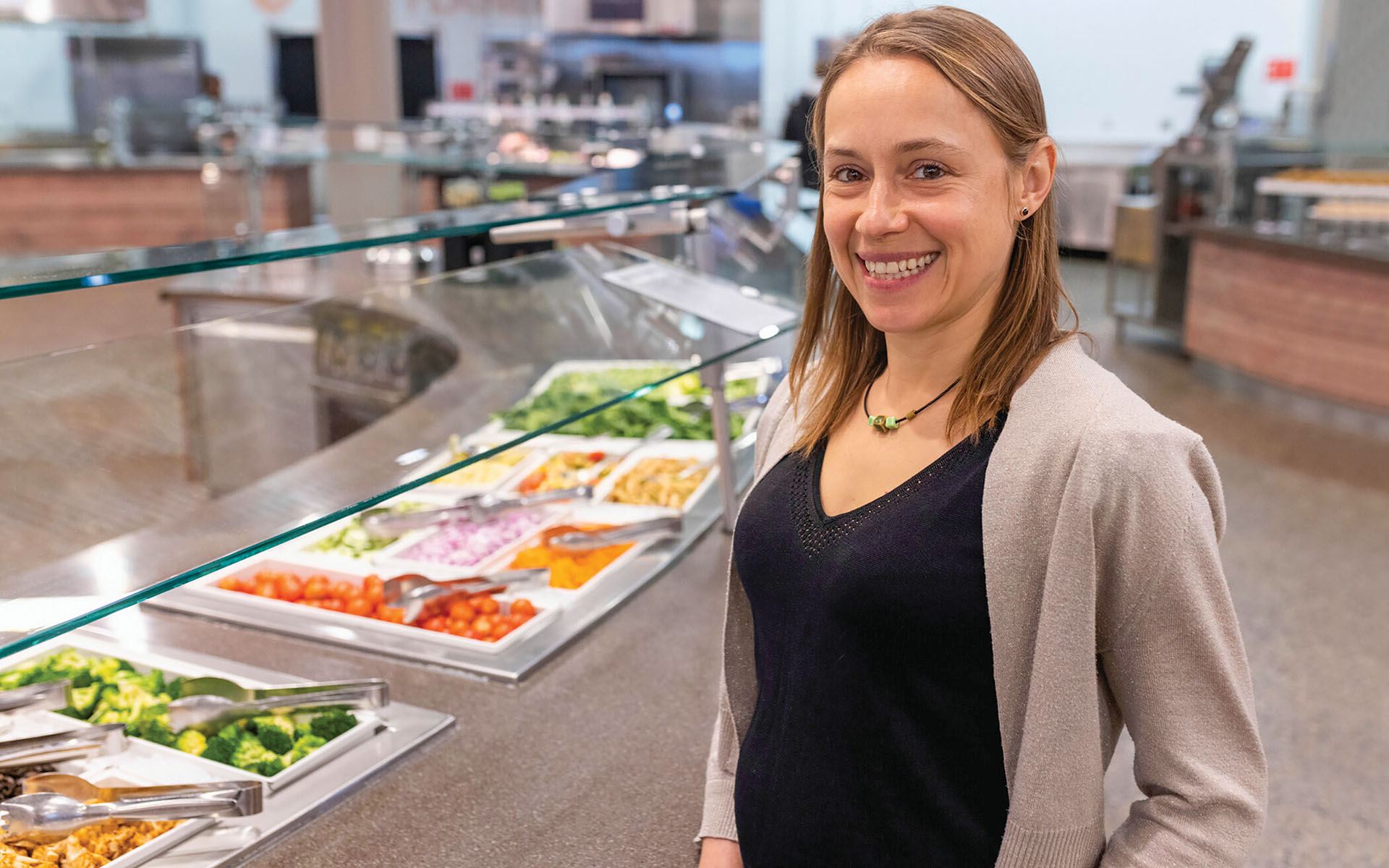
Dr. Dorothée Honhon
Eliminating Food Waste
While sustainable farming practices can help improve responsible food production, food waste remains a staggering problem.
According to the United Nations, about 14% of the world’s food — valued at $400 billion annually — is lost after harvest, before it ever reaches a retail shop. A further 17% is wasted in retail and by consumers. It’s estimated that this food altogether could feed 1.26 billion hungry people every year.
Avoiding food waste goes far beyond just cleaning your plate.
Dr. Dorothée Honhon, professor of operations management in the Naveen Jindal School of Management, studies the various ways that food goes unused at each step of the supply chain.
“The breakdown of where waste occurs for different products helps researchers start to determine how to help partners in the supply chains reduce food waste,” she said.
Every stage of the cycle is imperfect. While fruits and vegetables are most wasted on store shelves, dairy products expire at both the distribution stage and the consumer level.
“Many prepackaged goods move very slowly through the supply chain, sitting in warehouses for weeks or months, then again at a distribution center,” Honhon said. “When they arrive at a store, they have very little shelf life left.”
Honhon’s research is helping to define product-specific, supply-chain rules to minimize losses.
“We emphasize the first-in, first-out principle — you always want to move the oldest unit to the next stage,” she said. “It sounds so obvious, but it is not often practiced at the warehouse level as employees grab boxes to put on trucks.”
At the last stage, the biggest hurdle is educating consumers what “best by” or “use by” dates mean. Honhon said that, with the exception of baby formula and perishables exhibiting spoilage, consuming a product past the date on its package isn’t a risk.
“It’s probably very safe to eat. It’s about optimal taste — that’s how manufacturers choose dates,” she said. “The USDA recommends that if something’s past its ‘best by’ date in your fridge, open it; smell it; taste it. If it’s good, eat it.”
Wasted food was a particular problem during the early months of the COVID-19 pandemic, which exposed inefficiencies in supply chains.
“Products that could have been repurposed were wasted,” Honhon said. “Dairy products intended for schools were lost when schools closed because companies failed to pivot, repackage and redistribute to grocery stores. When restaurants closed, the meat supply intended for them also was wasted. We simply weren’t prepared for a disruption of this scale.”
Honhon said individuals can do their part to prevent food waste in their own homes by carefully planning meals before shopping and by eating their leftovers.
“Try to let your fridge decide what you eat, not the other way around,” she said. “First-in, first-out at home, too.”
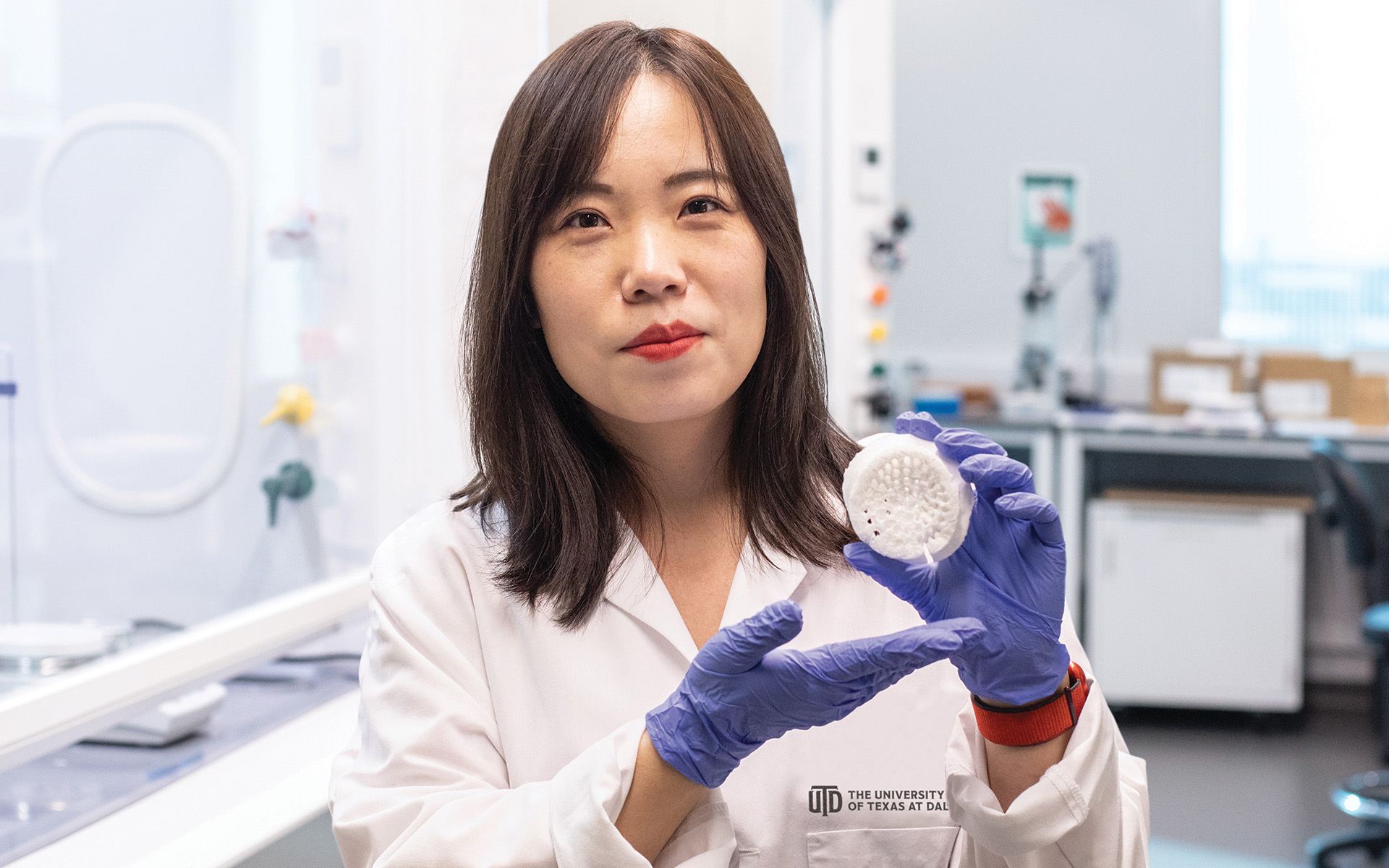
Dr. Shuang (Cynthia) Cui holds thermo-responsive hydrogel.
Cool Energy
According to the U.S. Department of Energy (DOE), the buildings sector, including both residential and commercial structures, accounts for 40% of U.S. primary energy use and associated greenhouse gas emissions. Much of that energy is wasted through inefficient heating and cooling.
“It’s imperative that we develop energy-efficient building technologies and practices to reduce energy consumption,” said Dr. Shuang (Cynthia) Cui, assistant professor of mechanical engineering in the Erik Jonsson School of Engineering and Computer Science who was a researcher at the National Renewable Energy Laboratory (NREL) before joining the UT Dallas faculty in 2021.
Cui is studying how hydrogels — materials that absorb and retain water — could be used for more efficient thermal management of buildings.
Hydrogels are found in everyday products such as contact lenses, diapers and wound dressings. Cui works with thermo-responsive hydrogels, which are affected by temperature changes. Below a critical temperature, these hydrogels absorb moisture and expand. Above a critical temperature, the materials release water through evaporation, resulting in a cooling effect similar to how sweat cools the body.
“Hydrogels are environmentally friendly, superabsorbent polymers nicknamed ‘solid water’ — they are more than 90% water by weight and can absorb a lot of water while maintaining a solid surface,” Cui said.
She is examining ways to adjust the functionality of hydrogels so they can be used as durable and reusable “sweating skins” to cool buildings without using electrical power. In the heat of the day, a hydrogel coating on the roof could dissipate heat, resulting in a reduction in the surface temperature of the building, which in turn would reduce the energy needed for air conditioning.
As a graduate student at the University of California, San Diego, Cui demonstrated the cooling performance of non-thermo-responsive hydrogels by reducing the top roof surface temperature of wooden house models by 25 to 30 degrees for up to seven hours after only a single hydration/evaporation cycle.
Thermo-responsive hydrogels also could be “tuned” to be incorporated into buildings for humidity control or for additional thermal energy storage, allowing for energy-efficient control of indoor temperature and humidity in different climates.
Cui said hydrogels can be engineered for many other applications by altering their chemical properties. Last fall, she received a $2.3 million DOE grant to develop thermo-responsive hydrogels that can dry paper and other materials more efficiently during manufacturing. Current methods rely on converting water in the paper to vapor via evaporation, which requires significant energy. In collaboration with her UT Dallas colleague Dr. Hongbing Lu, professor of mechanical engineering and holder of the Louis Beecherl Jr. Chair, and researchers at Western Michigan University, Auburn University and NREL, Cui is developing polymers that, instead, can absorb water from paper and then release it as liquid rather than convert it to vapor.
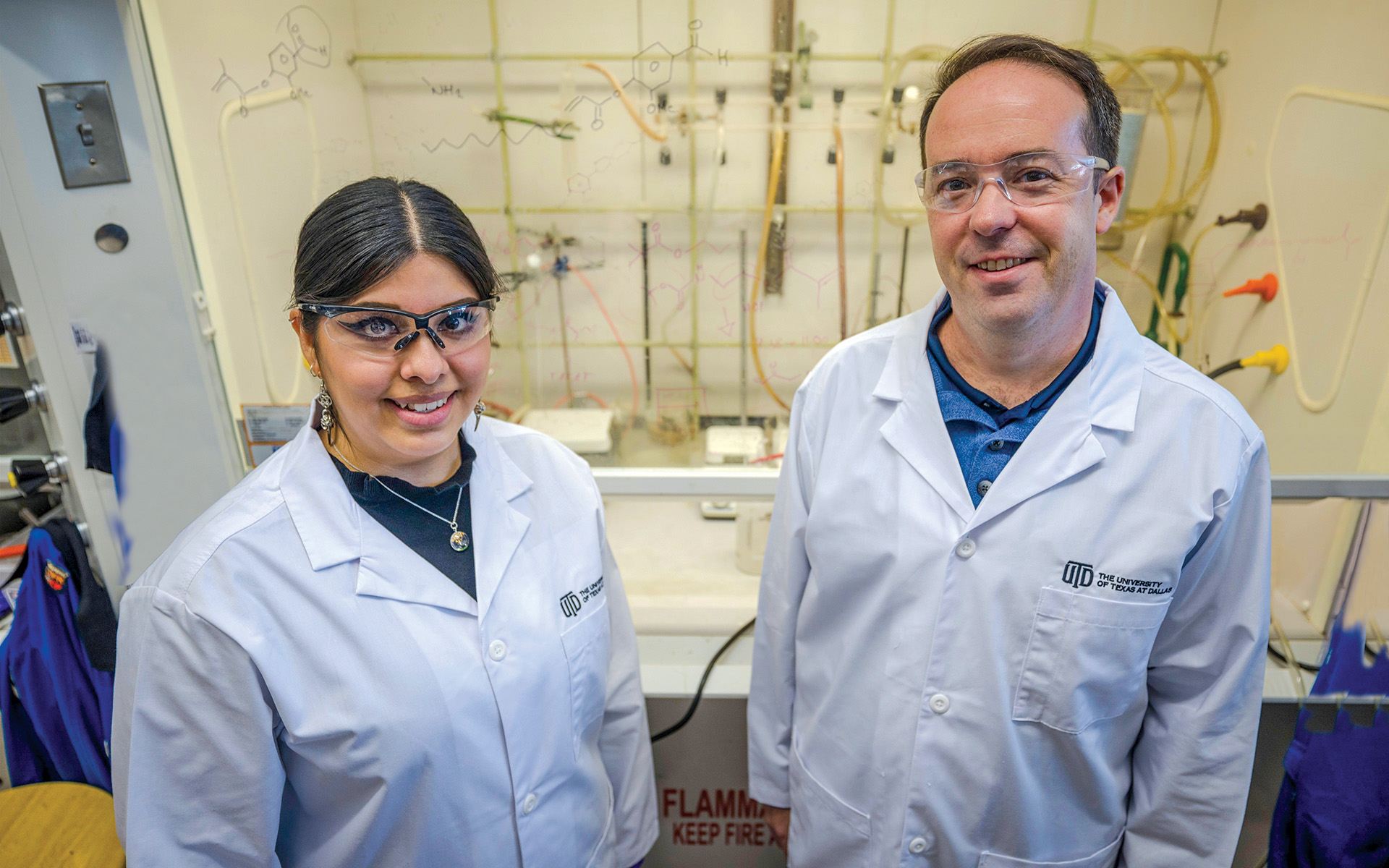
Karen Paola Cortés-Guzmán and Dr. Ron Smaldone
Sustainable Manufacturing
UT Dallas researchers are investigating potential sustainable manufacturing practices, such as 3D printing.
Dr. Ron Smaldone, associate professor of chemistry and biochemistry, and members of his lab are developing recyclable, biobased materials for 3D printing.
“Most 3D-printed materials are plastics, which are made from fossil fuels. They have a high carbon footprint and limited useful life, so there is a need for renewable alternatives,” said Karen Paola Cortés-Guzmán, a chemistry doctoral student.
The basis of their current work is vanillin, which can be extracted from vanilla beans or derived from lignin, which is a biowaste byproduct of the paper industry. The chemical structure of vanillin allows it to be manipulated in ways that result in different functionalities.
In research described in the journal ACS Sustainable Chemistry & Engineering, Cortés-Guzmán and Smaldone synthesized five different vanillin-based formulations and 3D-printed various items using digital light projection. The resulting “printouts” displayed a wide range of mechanical properties.
“These starting materials are liquids, so they are compatible with light-based 3D printers,” Cortés-Guzmán said. “Additionally, because we use vanillin, they smell very good.”
By subjecting them to heat, the materials also can self-heal, unlike most conventional plastics.
“If you get a scratch or crack in a traditional plastic, it might fail, and you’d have to throw it away,” Cortés-Guzmán said. “Our materials have an increased useful lifespan, keeping them out of landfills.”
To demonstrate recycling of the materials, the researchers ground them up and subjected them to high heat and pressure. The resulting materials were able to be remolded, which is not possible with many printed plastics.
“We have not yet done experiments to reprint the recycled materials, but that is the next step, exploring chemical recycling or upcycling into another product,” Cortés-Guzmán said.
Smaldone said 3D printing itself has the potential to grow into a green technology because items can be printed on demand, reducing the resources needed for storage and shipping.
“Almost all materials used now in 3D printing are conventional plastics. That’s why Karen’s work is so important,” Smaldone said. “The ability to 3D-print these biobased materials takes them from being a niche curiosity in green polymers to potentially the next step toward truly green manufacturing.”
Cortés-Guzmán was introduced to UTD and Smaldone in the summer of 2018 when she participated in the UT Dallas-Mexico Summer Research Program, which pairs faculty mentors with undergraduates from Mexico. She later received a ConTex doctoral fellowship, which provides funding to Mexican students pursuing PhDs at UT System institutions.
“I fell in love with the research and knew I wanted to come to UTD for my graduate work,” she said. “Chemistry is usually associated with negative impacts on the environment. As a scientist, I want to be able to do something with chemistry that is going to be of benefit to the environment in the long run.”
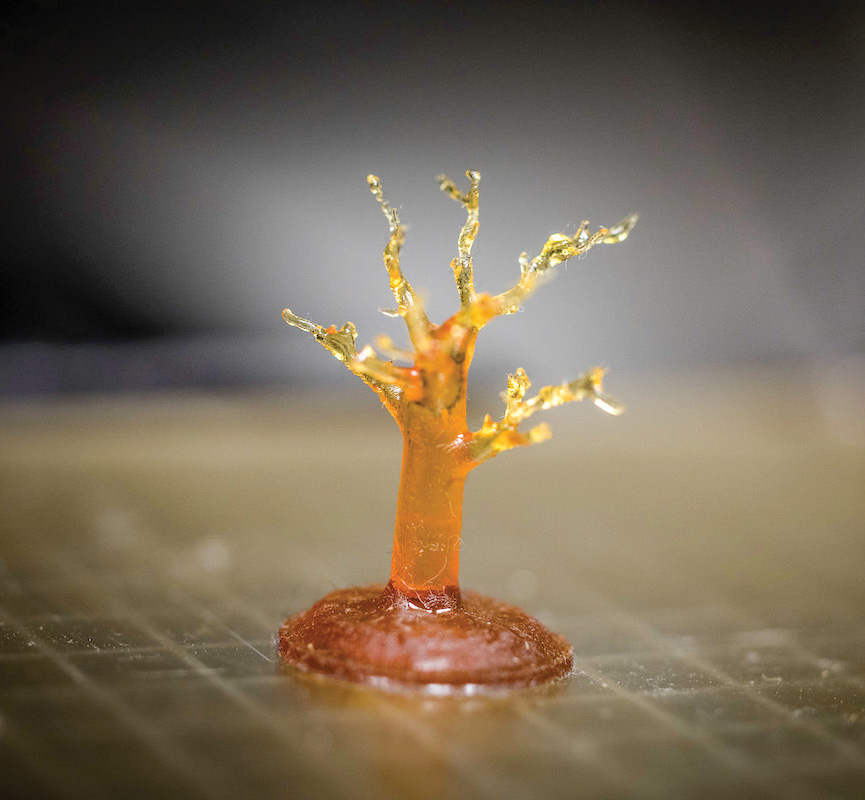
An item 3D-printed in Dr. Ron Smaldone’s lab using a biobased material.


